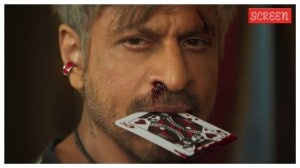1971 Pakistan Army surrender photo replaced keeping with new challenges, important for symbolism: Army chief
The portrait’s removal last month created a political controversy. It was later installed in the Indian Army chief’s lounge at the Manekshaw Centre.
 While addressing the Army’s annual press conference, Gen Dwivedi chief brushed aside criticism that mythology had been given primacy over the Army’s glory. (PTI Photo)
While addressing the Army’s annual press conference, Gen Dwivedi chief brushed aside criticism that mythology had been given primacy over the Army’s glory. (PTI Photo)The replacement of the portrait of the 1971 Pakistan Army surrender with that of Krishna and Arjun against the backdrop of Pangong Tso in Ladakh in the Indian Army headquarters is in keeping with the challenges the force is facing, Army chief General Upendra Dwivedi said Monday.
Last month, the removal of the portrait, which was later installed in the Indian Army chief’s lounge at the Manekshaw Centre, created a political controversy. Congress MP from Wayanad Rahul Gandhi raised the issue during Zero Hour in Parliament and asked the government to reinstall it in the Army headquarters. Gandhi argued the photo of the Pakistan army’s surrender following its defeat in the 1971 Bangladesh Liberation War, captured the Army’s glorious history.
The painting had been replaced by another painting titled ‘Karma Kshetra’. The new portrait shows Pangong Lake along the India-China border and also features modern military assets such as boats, all-terrain vehicles, tanks, and Apache helicopters. The artwork also shows mythological figures like Lord Krishna guiding Arjuna’s chariot in the Mahabharata as well as Chanakya.
While addressing the Army’s annual press conference, Gen Dwivedi chief brushed aside criticism that mythology had been given primacy over the Army’s glory.
“It is also said these are mythological. If you open Chapter IV of the original Constitution, the painting that is there is of Krishna and Arjun on the same chariot. So, is the Constitution also mythological? The modern technology is visible there (in the new painting). So, if I have to connect past, present and future, this symbolises that,” he said.
Explaining the decision to remove the 1971 portrait, Dwivedi said, “There are two chief lounges. There is one chief lounge here (Manekshaw Centre) and one chief lounge in the South Block. By year-end, we should be vacating South Block if Thal Sena Bhawan comes up in time. December 16 was chosen as the date to place that surrender painting at Manekshaw Centre because that is an auspicious day. As far as the other chief lounge is concerned, it is a mural, it cannot be removed from there. So, I had to take the decision from where to take it out.”
Gen Dwivedi said the new painting was conceptualised and made by Lt Col Thomas Jacob of the Madras regiment, adding it is “the younger generation”. “If you see the golden history of India, it has three chapters. It has the British era, the Mughal era, and the era before that. So, if you connect that and the vision I have given, symbolism becomes important. If I am talking about rebalancing 1.5, please understand it is against which potential adversary,” Gen Dwivedi said.
Rebalancing 1.5 refers to the restructuring and re-orientation the Army is going through in the wake of the 2020 Galwan clash in Eastern Ladakh and the challenge it is facing from the Chinese army on the northern border.
“So, if you look at that, my communication with my younger generation becomes equally important. Therefore, there is a surrender portrait which is in the chief lounge here at the Manekshaw Centre. And there is a new portrait that is there,” he added.







